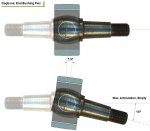Can you adapt 5-ton rods?
Five ton rods would have a different characteristic in terms of flex (twist), so even if they were adapted to fit because you liked their length, the handling would be affected.
There might only be one way to rigorously and scientifically settle the issue of whether an extended strut has suitable torsional characteristics.
We need an experiment: Someone with a spare stock Deuce rod and some heavy benchwork can do this. Here's how:
Securely affix one end of the Deuce rod to an immovable object, perhaps by welding the eye to a welding table. Orient the rod in the same manner as if it were on the truck, that is, with the center axis of the eye also parallel to the floor.Let the other end of the rod extend straight out, parallel to the floor.
Now, rig up a piece of angle iron - edge up - to support the distal end of the torque rod. You want a 'knife edge' (not literally) so that the rod is supported but can still twist unimpeded (no friction).
Now rig up a, say, two foot steel pipe. Weld one end to the free eye so that the pipe is parallel to the floor and extends out two feet. Drill the far end of the pipe for an eyebolt.
Affix a welding rod out the other side of the same eye, say 6 " out. Rig an easel or something with a piece of poster board. With everything at rest, mark your 'zero degrees' point.
What we are going to do now is to degree the torque rod, just like degreeing a camshaft (only different).
Hang 100 lbs off the end of the pipe, using the eyebolt. Mark where the pointer is now. Drawing a line from the zero point straight back the 6" to the center of rotation (the center of the eye), and then another line to the point with 100 lbs loaded, gives you (using a protractor) the number of degrees deflection with 200 foot pounds applied. Now repeat the experiment with 200 pounds - gives the deflection under 400 foot pounds of torque. Repeat, increasing the weight as you go. Now we will have a graph of degrees torsional deflection of a stock Deuce torque rod per amount of torque (twisting force). It might take a lot of weight before you see significant torcsional deflection - just think of how much the rear of a Deuce weighs. Another reason for this experiment to be done by someone with a heavy shop, as you might need to hang some serious weight.
Repeat the experiment with a lengthened torque rod - whether spliced or fabricated. If the torsion curves are close, you are golden. If not, well then the handling (articulation) of your Deuce has been compromised if it is higher (stiffer), and potentially unstable if it it less (easier to twist).
Note: if you have a magnetic protractor like those used to set pinion angles, you could dispense with the welding rod pointer and cardboard.
I am sure that someone on this Forum could knock out this experiment in a couple of hours. The results would be illuminating in terms of understanding any possible untoward effects from extending torque rods.


